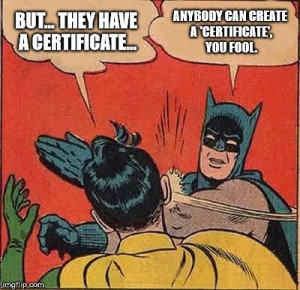A cursory look at some ‘predatory’ journals
Last week a researcher got in contact because some of his colleagues (at an academic department in a developing country) had asked him to check a list of journals – he suspected that they were dodgy journals and asked us to verify this. I did a quick bit of research and in each case I spotted at least one or two ‘red flags’ on each journal which suggested they were ‘predatory’ or appallingly low quality. I thought I would adapt this advice to a shareable blog post, as the list contains some good examples of deceptive and terrible journals that you should avoid at all costs (this post has also been shared already on the AuthorAID Discussion group). So let’s dive right in!
Journal 1 – Academia Journal of Scientific Research
https://www.academiapublishing.org/journals/ajsr/
The journal prominently claims to have an Impact Factor*. This is not the kind of Impact Factor journal your supervisor told you to publish in – journals have to be indexed in the Clarivate (formerly Thomson Reuters) Web of Science to get an Impact Factor, so it should be listed here: http://mjl.clarivate.com/ (spoiler alert: it’s not)
Journal 2 – International Journal of Development Research
Quality of the website suggests this is not an ‘international’ journal. But also, claims to be ‘UGC approved’ (by Indian University Grants Commission)… but it’s not listed here: https://www.ugc.ac.in/journallist/ (there is more information via this link about the history and criteria of the UGC list).
Fake association with Thomson Reuters.
 Furthermore, they create a fake association with Thomson Reuters. The Thomson Reuters ‘Researcher ID’ website is for individual researchers to identify themselves and list their publications, but many predatory journals are registering accounts using just their journal name. They do this so they can link to this page from their website, and it *looks* like they have an official Thomson Reuters page. Clever.
Furthermore, they create a fake association with Thomson Reuters. The Thomson Reuters ‘Researcher ID’ website is for individual researchers to identify themselves and list their publications, but many predatory journals are registering accounts using just their journal name. They do this so they can link to this page from their website, and it *looks* like they have an official Thomson Reuters page. Clever.
Needless to say, the journal is not listed on the official website: http://mjl.clarivate.com/
Journal 3 – World Journal of Scientific Research and Reviews (WJSRR)
Like many of the journals here, the scope of the journal “scientific research” is very broad and should make you sceptical of their ability to be able to cover such a wide range of subjects! It might be useful to compare and contrast this with Science or Nature, which are well-established international, multidisciplinary journals.
This is the Editorial Board listing for Nature Scientific Reports: https://www.nature.com/srep/about/editorial-board – as you can see it has an extensive list of editors covering every area under the natural and clinical sciences, so you can be confident in their expertise in your subject area. Compare this with WJSRR: http://wjsrr.com/Editor%20Board.php. Not quite in the same league, is it?
Also, the paragraph below is what we might call ‘gobbledygook’. It’s repetitive, incomprehensible English and says nothing about the scope of the journal. Also see the worrying red text – your paper will be ‘published without delay’. That doesn’t bode well for rigorous peer review.
“World Journal of Scientific Research and Reviews (WJSRR) is peer reviewed, online an open journal. It serves as a World Journal of Scientific Research and Reviews (WJSRR) forum of scholarly / researcher / academician research related to Scientific Research and Reviews Research. World Journal of Scientific Research and Reviews (WJSRR) are covers all the fields of Scientific Research related. There is no limit and covered full length research article, short communication, review paper and case study etc. World Journal of Scientific Research and Reviews (WJSRR) are inviting you to submit your paper and paper will publish without delay. World Journal of Scientific Research and Reviews (WJSRR) journal content will review by most prominent experts in the respective field. All published journal reader can read absolutely free.”
Journal 4 – Asian journal of science and technology

Professor Yildirim looks like he is quietly seething that somebody has spelt ‘physical’ wrong on his nice banner.
Again, this claims to be ‘UGC approved’ – but it isn’t https://www.ugc.ac.in/journallist.
Also, let’s look at the aims and scope to find out more information… oh, ‘page not found’ http://www.journalajst.com/about-journal
Journal 5 – International Journal of Advanced Research
This journal has a link to ‘Impact Factor’ on the homepage which goes to this page: http://www.journalijar.com/impact-factor-2014/ showing a gallery of nice certificates for something called ‘Scientific Journal Impact Factor’.
This is a fake/meaningless ‘impact factor’ (find out more information on fake impact factors here) that has no credibility in the scholarly community. Again, a journal only qualifies for an Impact Factor if its listed here: http://mjl.clarivate.com/
Also, their Editor in Chief is a ‘Dr Morse Florse’ of the UK. What a great name! Unfortunately, there is no institutional affiliation listed, it just says he is in the UK, so no way of checking his credibility. I did a search on Google for ‘Morse Florse’ and there is no information on this person, except that he is listed as an editor in chief for lots of journals with similar names. I’m pretty sure this is a fake name, and perhaps based on the fictional detective Inspector Morse.
Journal 6 – Applied science and innovative research**
http://www.scholink.org/ojs/index.php/asir/index
The Editor of the journal is a ‘Lisa Brown’, an employee of the publisher ‘Scholink’. What credentials does she have to be an editor of a multidisciplinary journal? There are no other details provided, and I was unable to find any information on her online.
They also provide a list of indexes which contains at least 3 fake impact factors:
• Global Impact Factor (GIF)
• Cosmos Impact Factor
• Universal Impact Factor
Conclusion
Summing up, all of these journals should be avoided at all costs. Additionally, I would suspect that any researcher who has shortlisted these sort of journals as potential target journals for their research is looking in totally the wrong place. Perhaps they have been paying too much attention to the spam they receive in their inbox (credible journals never send you unsolicited emails folks!). Or perhaps they did a Google search for ‘international journal’ or ‘research journal’, when in fact it would be much wiser to think about their specific research field first, rather than the grand-titled (fake) multidisciplinary journals listed above. They should be more realistic – afterall, most good-quality academic journals are very niche and serve a specific audience.
After sharing this post on AuthorAID, an author got in contact with me to say that he had an article accepted by one of the above journals and was about to pay an APC when he saw this. He provided copies of the acceptance letter, ‘reviewer comments’ and invoice. More on this next time!
* Impact factors – I’m aware that the Impact Factor is not a perfect measure of journal quality or research integrity. There are a growing number of critics of the metric, and in fact there are tens of thousands of perfectly credible journals that do not even quality for this metric. However, many ‘predatory’ journals advertise their fake Impact Factors quite prominently to entice unwary researchers into thinking they have prestige, so it’s important that those researchers know how to check the claims of these journals and cross-check with the Clarivate website.
** This journal is quite strange. They have tried to make their journals seem quite credible, with some standard Open Access practices – CC-BY licenses, the authors retaining copyright, and working DOIs. However, an organisation that lists offices in London and Los Angeles should not have grammatical errors on their homepage.




